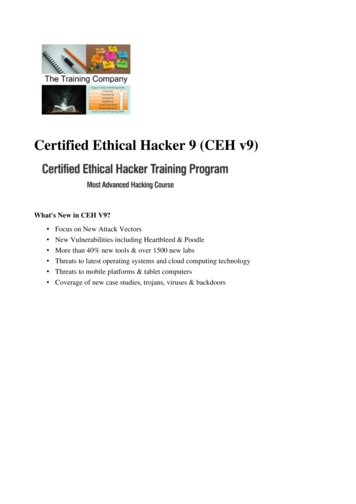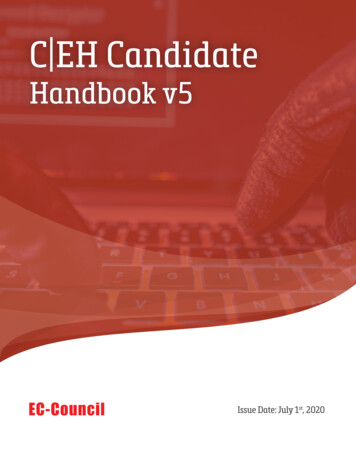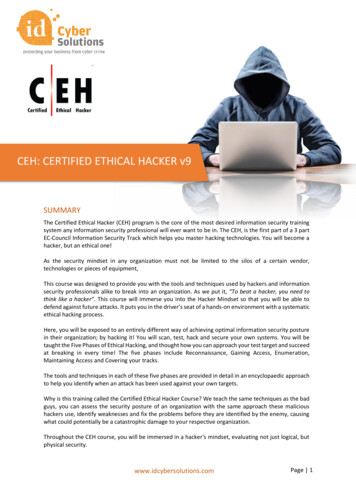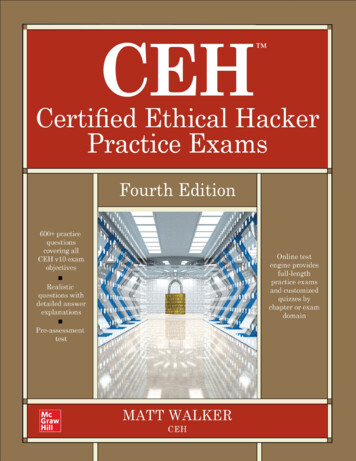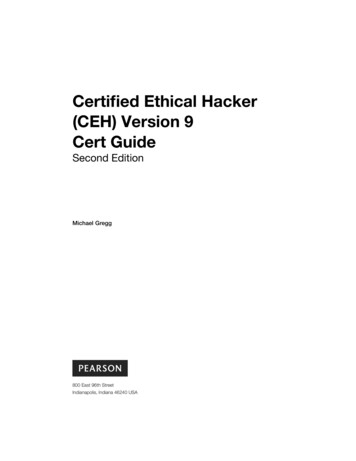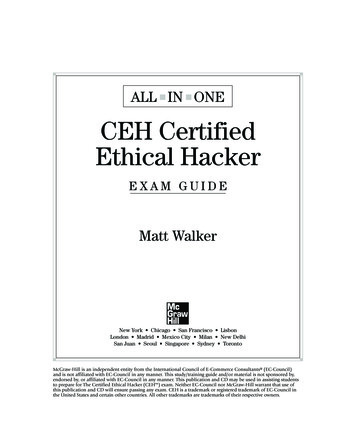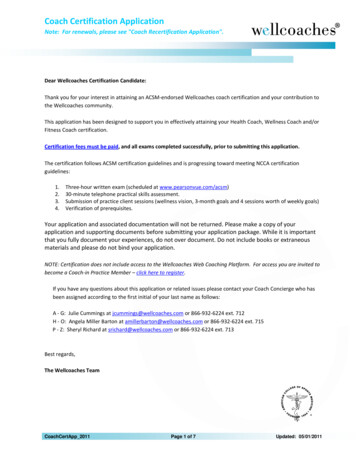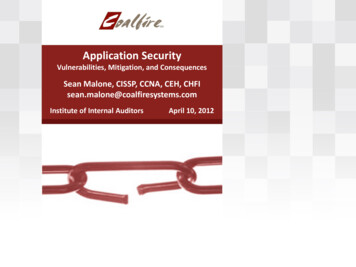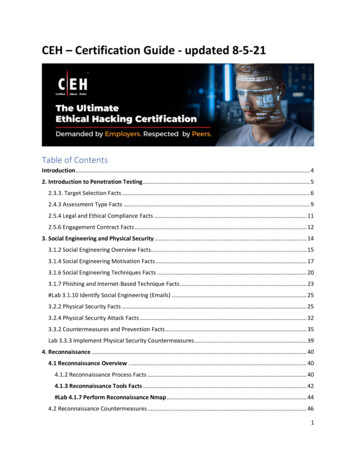
Transcription
CEH – Certification Guide - updated 8-5-21Table of ContentsIntroduction . 42. Introduction to Penetration Testing . 52.3.3. Target Selection Facts . 62.4.3 Assessment Type Facts . 92.5.4 Legal and Ethical Compliance Facts . 112.5.6 Engagement Contract Facts . 123. Social Engineering and Physical Security . 143.1.2 Social Engineering Overview Facts. 153.1.4 Social Engineering Motivation Facts . 173.1.6 Social Engineering Techniques Facts . 203.1.7 Phishing and Internet-Based Technique Facts . 23#Lab 3.1.10 Identify Social Engineering (Emails) . 253.2.2 Physical Security Facts . 253.2.4 Physical Security Attack Facts . 323.3.2 Countermeasures and Prevention Facts . 35Lab 3.3.3 Implement Physical Security Countermeasures . 394. Reconnaissance . 404.1 Reconnaissance Overview . 404.1.2 Reconnaissance Process Facts . 404.1.3 Reconnaissance Tools Facts . 42#Lab 4.1.7 Perform Reconnaissance Nmap . 444.2 Reconnaissance Countermeasures . 461
#Lab 4.2.3 Disable Windows Services . 46#Lab 4.2.5 Manage Linux Services . 47#Lab 4.2.6 Enable and Disable Linux Services . 484.2.7 Reconnaissance Countermeasures Facts. 48#Lab 4.2.9 Hide the IIS Banner Broadcast. 495. Scanning. 505.1 Scanning Overview . 505.1.2 Scanning Process Facts . 505.1.3 Scanning Tools Facts . 53Lab# 5.1.5 Perform an Internal Scan. 55Lab# 5.1.6 Perform an External Scan Using Zenmap. 555.1.9 Scanning Considerations Facts. 555.2 Banner Grabbing . 575.2.2 Banner Grabbing Facts . 586. Enumeration . 596.1 Enumeration Overview . 596.1.5 Enumeration Facts. 596.1.8 Enumerate Ports and Services Facts . 65Lab# 6.1.9 Perform Enumeration with Nmap . 66Lab# 6.1.11 Perform Enumeration with Metasploit . 67Lab# 6.1.12 Perform Enumeration of MSSQL with Metasploit . 676.2 Enumeration Countermeasures . 686.2.2 Enumeration Countermeasures Facts . 68Lab# 6.2.4 Prevent Zone Transfer . 697. Analyze Vulnerabilities. 707.1 Vulnerability Assessment . 707.1.2 Vulnerability Assessment Facts . 707.2 Vulnerability Management Life Cycle. 747.2.2 Vulnerability Management Life Cycle. 757.2.4 Vulnerability Solution Facts . 777.3 Vulnerability Scoring System . 797.3.2 Vulnerability Scoring Systems Facts . 797.4 Vulnerability Assessment Tools . 822
7.4.2 Vulnerability Assessment Tool Facts. 83Demo# 7.4.3 Scan a Network with Retina . 86Demo# 7.4.4 Scan a Network with Nessus . 87Lab# 7.4.5 Scan for Vulnerabilities on a Windows Workstation . 87Lab# 7.4.6 Scan for Vulnerabilities on a Linux Server . 89Lab# 7.4.7 Scan for Vulnerabilities on a Domain Controller . 90Lab# 7.4.8 Scan for Vulnerabilities on a Security Appliance . 92Lab# 7.4.9 Scan for Vulnerabilities on a WAP . 948. System Hacking . 978.1 System Hacking . 978.1.1 Introduction to Hacking Lecture . 978.1.2 Introduction to Hacking Facts . 97Demo# 8.1.3 Keylogger Attack. 103Lab# 8.1.4 Analyze a USB Keylogger Attack . 103Lab# 8.1.5 Analyze a USB Keylogger Attack 2 . 104Demo# 8.1.6 Use Rainbow Tables . 105Lab# 8.1.7 Crack a Password with Rainbow Tables . 107Demo# 8.1.8 Crack Passwords . 107Demo# 8.1.9 Crack Password Protected Files . 111Lab# 8.1.10 Crack a Password with John the Ripper . 112Demo# 8.1.11 Crack a Router Password . 113Demo 8.1.12 Use L0phtCrack to Audit passwords . 119Demo# 8.1.13 Configure Password Policies . 120Lab# 8.1.14 Configure Account Password Policies . 1218.2 Privilege Escalation . 1218.2.1 Privilege Escalation in Windows – Lecture . 1218.2.2 Use Bootable Media to Modify User Accounts . 1218.2.3 Crack the SAM Database . 1308.2.4 Change a Windows Password . 1328.2.5 Privilege Escalation in Windows Facts . 1368.2.6 Crack the SAM Database with John the Ripper . 1388.2.7 Configure User Account Control . 140References . 1503
Testout . 150LinkedIn Learning . 150ExamTopics . 150Oreilly eBook . 150Demos . 1501.Understanding TCP sequence numbers . 1502.Hijacking a Telnet session . 151Tools and Utilities . 1511.Device security evaluator on Windows Pc . 1512.MD5 Hash Generator . 151IntroductionThis is an All-In-One study guide for the CEHv11 Certification.4
2. Introduction to Penetration Testing5
2.3.3. Target Selection Facts2.3.3Target Selection FactsBefore beginning a penetration test, there are a lot of details that must be worked out.These details include the type of test being performed and any test limitations. After theinitial plans and details for a penetration test have been put together, there are someadditional details that should be considered. These include performing a risk assessment,6
determining tolerance, scheduling the test, and identifying security exceptions that may beapplied to the penetration tester.This lesson covers the following topics: Penetration test planningSecurity exceptionsRisk assessmentDetermine toleranceScope creepPenetration Test PlanningDetailDescriptionHowOne of the first items to consider is the type of test to be performed, internal orexternal. An internal test focuses on systems that reside behind the firewall. Thiswould probably be a white box test. An external test focuses on systems that existoutside the firewall, such as a web server. This would, more than likely, be a blackbox test.WhoDetermine if the penetration tester is allowed to use social engineering attacks thattarget users. It's common knowledge that users are generally the weakest link in anysecurity system. Often, a penetration test can target users to gain access. Youshould also pre-determine who will know when the test is taking place.WhatThe organization and the penetration tester need to agree on which systems will betargeted. The penetration tester needs to know exactly which systems are beingtested, and as they cannot target any area that isn't specified by documentation. Forexample, the organization may have a website they do not want targeted or tested.Some other systems that need to look at include wireless networks andapplications.WhenScheduling the test is very important. Should the test be run during business hours?If so, this may result in an interruption of normal business procedures. Running thetests when the business is closed (during weekends, holidays, or after-hours) maybe better, but might limit the test.WhereFinally, will the test be run on site, or remotely? An on-site test allows better testingresults but may be more expensive than a remote test.Security Exceptions7
A security exception is any deviation from standard operating security protocols. The typeof test (white box, black box, grey box) will determine what, if any, security exceptions thepenetration test will be given.Risk AssessmentThe purpose of a risk assessment is to identify areas of vulnerability within theorganization’s network. The risk assessment should look at all areas, including high valuedata, network systems, web applications, online information, and physical security(operating systems and web servers). Often, the penetration test is performed as part of arisk assessment.Once vulnerabilities have been determined, the organization needs to rank them andfigure out how to handle each risk. There are four common methods for dealing with risk:1. Avoidance: whenever you can avoid a risk, you should. This meansperforming only actions that are needed, such as collecting only relevantuser data.2. Transference: the process of moving the risk to another entity, such as athird party.3. Mitigation: this technique is also known as risk reduction. When the riskcannot be avoided or transferred, steps should be taken to reduce thedamage that can occur.4. Acceptance: sometimes the cost to mitigate a risk outweighs the risk'spotentially damaging effects. In such cases, the organization will simplyaccept the risk.Determine ToleranceAfter the risk assessment has been performed and vulnerable areas are identified, theorganization needs to decide its tolerance level in performing a penetration test. Theremay be areas of operation that absolutely cannot be taken down or affected during thetest. Areas of risk that can be tolerated need to be placed in the scope of work, and criticalareas may need to be placed out of the test's scope.Scope CreepIn project management, one of the most dangerous issues is scope creep. This is when theclient begins asking for small deviations from the scope of work. This can cause the projectto go off track and increase the time and resources needed to complete it. When a changeto the scope of work is requested, a change order should be filled out and agreed on. Oncethis is done, the additional tasks can be completed.8
2.4.3 Assessment Type Facts2.4.3Assessment Type FactsAn organization's purpose for completing a penetration test will dictate how the test will becarried out. Depending on the penetration test's goals, the ethical hacker may have specificrules and regulations that need to be observed. There are scenarios that will result inspecial considerations being made.This lesson covers the following topics: Goal-based penetration testObjective-based penetration testCompliance-based penetration testSpecial considerationsGoal-Based Penetration TestA goal-based penetration test will focus on the end results. The goals must be specific andwell-defined before the test can begin. The penetration tester will utilize a wide range ofskills and methods to carry out the test and meet the goals. When you determine the goalsof the exam, you should use S.M.A.R.T. goals. S – SpecificM – MeasurableA – AttainableR – RelevantT – TimelyObjective-Based Penetration TestAn objective-based test focuses on the overall security of the organization and its datasecurity. When people think of a penetration test, this is often what they think of. Thescope of work and rules of engagement documents specify what is to be tested.Compliance-Based Penetration TestEnsuring that the organization is in compliance with federal laws and regulations is a majorpurpose for performing a penetration test. Some of the main laws and regulations includethe following:RegulationDescription9
Payment CardIndustry DataSecurityStandards (PCIDSS)Health InsurancePortabilityandAccountability Act(HIPAA)ISO/IEC 27001Sarbanes OxleyAct (SOX)Defines the security standards for any organization that handlescardholder information for debit cards, credit cards, prepaid cards, andother types of payment cards.A set of standards that ensures a person's health information is keptsafe and only shared with the patient and medical professionals thatneed it.Defines the processes and requirements for an organization’sinformation security management systems.A law enacted in 2002 with the goal of implementing accounting anddisclosure requirements that would increase transparency in corporategovernance and financial reporting and formalizing a system of internalchecks and balances.Digital MillenniumCopyright Act(DMCA)Enacted in 1998, this law is designed to protect copyrighted works.FederalInformationSecurityManagement Act(FISMA)Defines how federal government data, operations, and assets arehandled.Special ConsiderationsThere are a few scenarios where extra or special considerations need to be considered,such as mergers and establishing supply chains. During a merger, a penetration test maybe performed to assess physical security, data security, company culture, or other facets ofan organization to determine if there are any shortcomings that may hinder or cancel themerger. When establishing a supply chain, a penetration test needs to be performed todetermine if there are any security issues or violations that could affect everyone involved.The organizations need to ensure that their systems can talk to each other and theirsecurity measures align. For these tests, companies may employ red teams and blueteams. They may also utilize purple team members.10
2.5.4 Legal and Ethical Compliance Facts2.5.4Legal and Ethical Compliance FactsAn ethical hacker's role is to break the rules and hack into an organization's network andsystems. Before this is done, both the penetration tester and organization must know andagree to everything being done. Once the scope of work is finalized, there may beadditional laws that need to be looked at and followed.This lesson covers the following topics: Federal lawsCloud-based and third-party systemsEthical scenariosCorporate policiesFederal LawsThere are two key federal laws that apply to hacking: Title 18, Chapter 47, Sections 1029and 1030. One thing that stands out in these laws is in most of the statements, the wordsunauthorized or exceeds authorized access are used. These keywords are what apply tothe ethical hacker. The ethical hacker needs to ensure they access only the systems towhich they have explicit permission and only to the level they have authorized access. Section 1029 refers to fraud and related activity with access devices. Anaccess device is any application or hardware that is created specifically togenerate access credentials.Section 1030 refers to fraud and related activity with computers or anyother device that connects to a network.In addition to the above two laws, the Wassenaar Arrangement on Export Controls forConventional Arms and Dual-Use Goods and Technologies was amended in 2013 to includeintrusion software. This agreement is between 41 countries that generally hold similarviews on human rights. The update in 2013 has led to a lot of issues and confusion in thecybersecurity field, as many of the tools used in the penetration testing process can also beused by black hat hackers for malicious purposes.In 2018, the Wassenaar Arrangement was updated to clarify some of these policies. Thiswill hopefully make things easier for some penetration testers involved in internationaltesting.Cloud-Based and Third-Party Systems11
When dealing with cloud-based systems or other third-party systems, specialconsiderations need to be made. If an organization is using a cloud-based system, thatmeans the organization doesn't own the system and cannot legally provide permission fora penetration test to be carried out on that system. The penetration tester must make sureto get the explicit permission from the cloud provider before performing any tests.Third-party systems can also cause some issues for the penetration tester. If systems areinterconnected, such as in a supply chain, the penetration tester needs to ensure they donot accidentally access the third party's systems at all. The penetration tester may also runacross vulnerabilities that can affect the third party. In this scenario, the penetration testerneeds to report findings to the client and let the client handle the reporting.Ethical ScenariosAside from the laws and regulations, the ethical hacker must be aware of scenarios whereethical decisions need to be made. One particular instance that can cause an issue is whenthe penetration tester resides in one state and the organization is in another state. Thelaws that govern computer usage and hacking can vary from state to state. When thisoccurs, the penetration tester and the organization need to agree on which set of laws theywill adhere to. Whenever there are any questions or concerns regarding laws andregulations, a lawyer should be consulted.There will be instances where the ethical hacker will run across data and may not be surewhat to do with it. There are instances, such as child pornography, that is considered amandated report - these sorts of findings must always be immediately reported, noexceptions. In any other situation where data is discovered that is not a mandated report,the data should be disclosed to the client. As always, when there is doubt about whichcourse of action to take, a lawyer should be consulted.Corporate PoliciesCorporate policies also play a role in how a penetration test is carried out. Corporatepolicies are the rules and regulations that have been defined and put in place by theorganization. As part of the risk assessment and penetration test, these policies should bereviewed and tested. Some common policies that most organizations have defined arepassword polices, update frequency, handling sensitive data, and bring your own devices.The organization needs to determine which, if any, of these policies will be tested during anassessment.2.5.6 Engagement Contract Facts2.5.6Engagement Contract Facts12
Before a penetration test can begin, there are a few key documents that must becompleted and agreed on. These documents are designed to protect both the organizationand the penetration tester.Even though much of this information could be put into a single document, it makes thingsmuch clearer when all the details are separated out into the documents described in thistable.DocumentScope of WorkDescriptionThe Scope of Work is one of the more detailed documents for a project.This document spells out in detail the who, what, when, where, and why ofthe penetration test. Explicitly stated in the Scope of Work are details of allsystem aspects that can be tested, such as IP ranges, servers, andapplications.Anything not listed is off-limits to the ethical hacker. Off-limit featuresshould also be explicitly stated in the Scope of Work document to avoid anyconfusion. This document will also define the test's time frame, purpose,and any special considerations.Rules ofEngagementThe Rules of Engagement document defines how the penetration test willbe carried out. This document defines whether the test will be a white box,gray box, or black box test. Other details, such as how to handle sensitivedata and who to notify in case something goes wrong, will be listed in thedocument.Master ServiceAgreementIt is very common for companies to do business with each other multipletimes. In these situations, a Master Service Agreement is useful. Thisdocument spells out many of the terms that are commonly used betweenthe two companies, such as payment. This makes future contracts mucheasier to complete, as most details are already spelled out.NonDisclosureAgreementThis is a common legal contract outlining confidential material orinformation that will be shared during the assessment and the restrictionsplaced on it. This contract basically states that anything the tester findscannot be shared, with the exception of those people stated in thedocument.Permission toTestThis document is often referred to as the get-out-of-jail-free card. Sincemost people in the client's organization will not know about the penetrationtest occurring, this document is used if the penetration tester gets caught.This document is used only as a last resort but explains what thepenetration tester is doing and that the work is fully authorized.13
3. Social Engineering and Physical Security14
3.1.2 Social Engineering Overview Facts3.1.2Social Engineering Overview FactsSocial engineering refers to enticing or manipulating people to perform tasks or relayinformation that benefits an attacker. Social engineering tries to get a person to dosomething the person wouldn't do under normal circumstances.This lesson covers the following topics: Manipulation tacticsSocial engineering processManipulation TacticsSocial engineers are master manipulators. The following table describes some of the mostpopular tactics they use on targets.15
Manipulation TypeDescriptionMoral obligationAn attacker uses moral obligation to exploit the target’s willingnessto be helpful and assist them out of a sense of responsibility.Innate human trustAttackers often exploit a target’s natural tendency to trust others.The attacker wears the right clothes, has the right demeanor, andspeaks words and terms the target is familiar with so that the targetwill comply with requests out of trust.ThreateningAn attacker threatens when they intimidate a target with threatsconvincing enough to make them comply with the attacker’s request.Offering somethingfor very little tonothingOffering something for very little to nothing refers to an attackerpromising huge rewards if the target is willing to do a very smallfavor or share what the target thinks is a very trivial piece ofinformation.IgnoranceIgnorance means the target is not educated in social engineeringtactics and prevention, so the target can’t recognize socialengineering when it is happening. The attacker knows this andexploits the ignorance to his or her advantage.Social Engineering ProcessThe social engineering process can be
Social Engineering and Physical Security . This is an All-In-One study guide for the CEHv11 Certification. 5 2. Introduction to Penetration Testing . 6 2.3.3. Target Selection Facts 2.3.3 Target Selection
